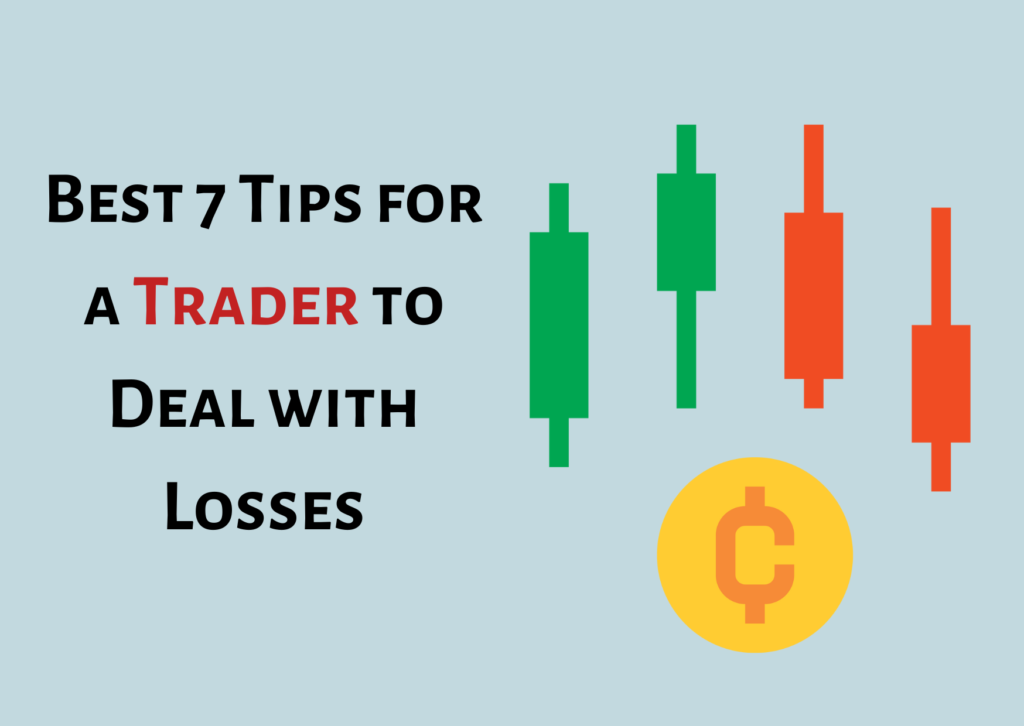Best 7 Tips for a Trader to Deal with Losses

Every trader has both wins and losses, regardless of their strategies and systems. Like in sports, traders do not win every trade like baseball players aren’t hitting every shot and basketball players don’t score every shot. Trading is a game that offers high win rates and positive expectations by achieving higher wins than losses on average. Beginners are often shocked by the emotion that comes from trading real money which did not exist during the development of the system. The way you handle your emotions and discipline when trading will determine the success of your trade even after you have developed a system that has an edge.
Here are seven important trade psychology tips to help you control your emotions during losing trades, and to maintain your discipline.
1. Don’t let a loss day cause you to lose more than your typical day of winning.
Your days of winning should be greater than the days you lose. One of the most important factors to being profitable is to keep your losses to a minimum and prevent them from expanding beyond their limits and growing bigger than your winnings. Consider your risk/reward ratio as a percentage of terms of time and dollars and should invest more time in profitable trades than in losing ones. Losing days shouldn’t be more than a typical successful day if you’re using stop loss and the correct size of your position.
2. Quantify your stop loss level before you enter a trade.
It is important to know the place you’re going to get out of trading before you enter. You should establish the price at which the trade is not allowed to be if the trade is right. Once you reach that point, you have to accept the loss in order to limit it to a small amount. Inquiring from others about what you should do when during a loss-making trade is an indication you do not have a trading strategy. Determine your risk at the beginning to determine your risk-to-reward ratio.
3. Avoid trading in revenge.
Revenge trading is an unjustified desire to recoup your losses in the same market or chart you have lost money on.
Revenge trading is usually caused by the ego feeling defeated by the stock and also seeking to even the playing field with the chart by gaining their losses back with new profits. The trader may become obsessed with getting the profits back on the exact chart that they have lost the money on in order to experience an improvement in their odds of trading it. It is possible to feel like they’re superior or winning against an imaginary opponent or market.
This is a major mental flaw for those who are highly competitive, who hates losing, and always need to prove that they were right.
The most straightforward solution is to not take losses personally, follow a plan that includes a diverse watchlist, and then move on to the next opportunity to trade. By utilizing the proper size of your position and risk management, every trade should only be one of the 100 trades and not involve the ego to fight the chart they did not make money on.
Also Read: 7 Thumb Rule To Know Before Investing In Cryptocurrency
4. You are responsible for trading results
The blame game can destroy the ability of traders to develop the ideal mindset for positive results in trading. In the end, we decided to use our system of trading We did our research before we took on and then left the trades, and we are the ones who decide what happened. Although we cannot control the market’s price, we can control our own actions and are required to accept the losses and successes.
The blame game of blaming the market, others the Federal Reserve, or politicians for our losses or losing streaks adds no value to our trading. Accepting the results of our plan as our own in the short term can be a good thing. The key to long-term success is learning and adapting to changing conditions and not repeating the same mistakes.
We are only responsible to follow our trading rules in a strict and consistent manner, not for what happens in the market. Our positive expectation model will play out with a profit, but in the short term, anything can occur.
5. Always trade in the event that you have an edge in the market.
Make sure you only trade only when your signals are activated and your edge is there. Not every day, and not every market situation is favorable to your strategy and system. Be aware of when to trade and when you should wait. When there’s nothing to do on the market, you must have the discipline to not do anything. Each trading system should include cash signals that indicate when to stay out of the market. Trading professionals don’t earn money for the activity they perform, they receive compensation for their correct activities.
6. Every trade must have the right size of the position.
The size of your position in your trades is based on the maximum amount you’d like to lose in an investment. A loss of over 1% of each trade could be risky. If I’m trading on an account of $100,000 I would not want to lose more than $1000 on a trade that is losing. A stop loss level needs to begin at the price at which you are sure you’re wrong, then move back to the size of your position. If the level of support on the trade you are trading is $105 at your entry, and you have put your stop at $100, you could trade 200 shares while keeping your stop at the price of $100. 200 x $105 = $21,000 size of the position to hold 200 shares. This amounts to roughly 20 percent of your trading capital, with a 5% stop loss for your position which equals a one percent loss on your capital for trading.
- A 20 percent position size of your total trading capital will give you a possibility of a stopping loss of 5% for your position, equal to one percent of the total capital for trading.
- A 10% size of the position of your trading capital will give you a possible 10 percent limit on the position that would the equivalent of 1% of your total capital for trading.
- A position size of 5% of your trading capital will give you the potential for a 20% stop loss for your position which is equal to 1% of your total capital for trading.
Average true range (ATR) will give you the daily price movements and assist you in determining you determine the size of your position according to your time frame and your stock’s volatility. If you enter at $105 the stop is $100 while the ATR of the stock is 1 you will have a five-day period of price volatility against you as a stop.
Begin with your stop loss threshold and then increase the volatility to allow the size of your position. The greater the space you’d like for your stop, the more much of a position you can afford.
If you are only able to lose one percent of your trading capital if you’re wrong, every trade is an additional 100, with very little emotional consequence. You can ultimately overcome losing streaks and boost your chances of success.
7. Concentrate on your trading system’s execution, not the result of one particular trade.
If you are focused on trading and trading using discipline and focus, in the long term, the results will take care of themself. You should focus on the positive expectation for your program, not on the outcomes of one particular trade. If you have the right size for your position each trade must be viewed in the context of one of your 100 trades.
A large amount of money or a desire to be correct on trade can cause a trader to be off balance and cause them to lose their ability to focus and remain emotionally balanced and implement their strategy with discipline. Concentrate on the process rather than the immediate results. A single trade may result in a random outcome, however, 100 trades are an effective filter to maximize your profit. The focus should be on the whole picture, not just one transaction.
These rules are powerful to enhance your trading plan’s parameters.
Disclaimer– This Website and related pages are only for information, educational & learning assistance. Please consult your financial advisor for assistance before investing. Personal opinion only for reviews, feedback, and educational purpose. We are not SEBI registered.




